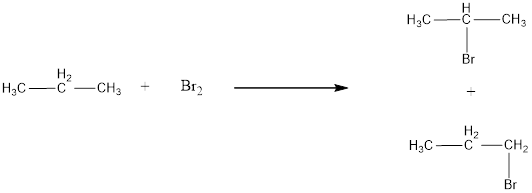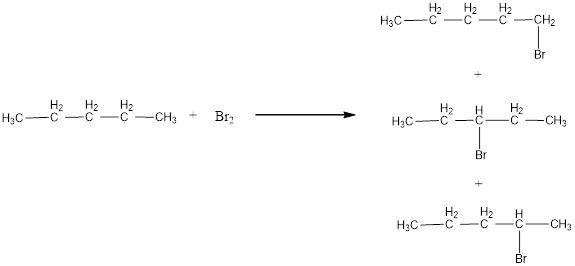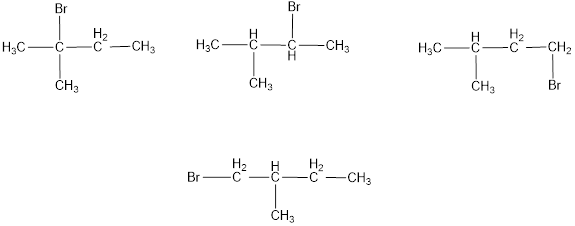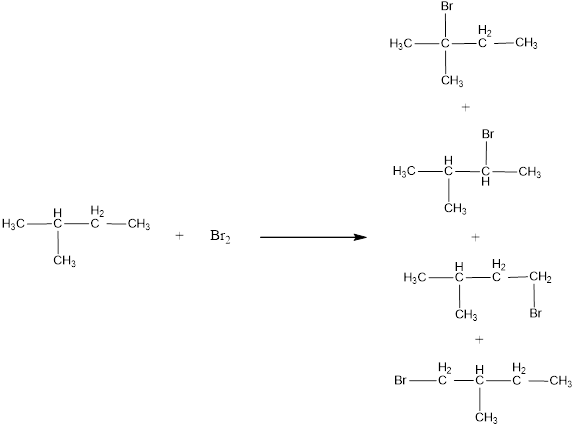
Concept explainers
(a)
Interpretation:
Structural formula for all the possible monobrominated products obtained from halogenation of propane has to be written.
Concept Introduction:
Alkanes are not completely inert. Two important reactions that alkanes undergo are combustion and halogenation.
Combustion reaction is the one where reaction occurs between substance and oxygen which proceeds with evolution of light and heat. Due to the heat produced when alkanes are made to undergo combustion with oxygen, it is used as fuel.
Halogenation is a
Halogenation reaction of alkane is an example of substitution reaction. This is a reaction where a part of reacting molecule replaces an atom or group of atoms in hydrocarbon or hydrocarbon derivative.
Cycloalkanes are also similar to those of alkanes. Cycloalkanes also undergo combustion and halogenation reaction.
(a)
Answer to Problem 1.134EP
The monobrominated products of propane are,

Explanation of Solution
Halogenation is a chemical reaction between a substance and halogen. The product of halogenation reaction is that one or more halogens are incorporated into molecules of the substance. Halogenation of hydrocarbon gives hydrocarbon derivatives as product where halogen atoms are substituted instead of hydrogen atoms.
Halogenation reaction of alkane is an example of substitution reaction. This is a reaction where a part of reacting molecule replaces an atom or group of atoms in hydrocarbon or hydrocarbon derivative.
General reaction for halogenation of alkane can be given as shown below,
The halogenation reaction takes place giving a mixture of products where the hydrogen atoms present in the alkane are substituted randomly.
Given alkane is propane. Two kinds of hydrogen is present in propane. Therefore, bromination of propane will lead to two monobrominated product as shown below,

The structural formula for monobrominated product of propane was drawn.
(b)
Interpretation:
Structural formula for all the possible monobrominated products obtained from halogenation of pentane has to be written.
Concept Introduction:
Alkanes are linear chain saturated hydrocarbons. The reactivity of alkanes are very less. They can be heated for a very long time in strong acids and bases without any reaction. Even strong reducing and strong oxidizing agents have less effect on alkanes.
Alkanes are not completely inert. Two important reactions that alkanes undergo are combustion and halogenation.
Combustion reaction is the one where reaction occurs between substance and oxygen which proceeds with evolution of light and heat. Due to the heat produced when alkanes are made to undergo combustion with oxygen, it is used as fuel.
Halogenation is a chemical reaction between a substance and halogen. The product of halogenation reaction is that one or more halogens are incorporated into molecules of the substance. Halogenation of hydrocarbon gives hydrocarbon derivatives as product where halogen atoms are substituted instead of hydrogen atoms.
Halogenation reaction of alkane is an example of substitution reaction. This is a reaction where a part of reacting molecule replaces an atom or group of atoms in hydrocarbon or hydrocarbon derivative.
Cycloalkanes are also similar to those of alkanes. Cycloalkanes also undergo combustion and halogenation reaction.
(b)
Answer to Problem 1.134EP
The monobrominated products of pentane are,

Explanation of Solution
Halogenation is a chemical reaction between a substance and halogen. The product of halogenation reaction is that one or more halogens are incorporated into molecules of the substance. Halogenation of hydrocarbon gives hydrocarbon derivatives as product where halogen atoms are substituted instead of hydrogen atoms.
Halogenation reaction of alkane is an example of substitution reaction. This is a reaction where a part of reacting molecule replaces an atom or group of atoms in hydrocarbon or hydrocarbon derivative.
General reaction for halogenation of alkane can be given as shown below,
The halogenation reaction takes place giving a mixture of products where the hydrogen atoms present in the alkane are substituted randomly.
Given alkane is pentane. Three kinds of hydrogen atoms are present in pentane. Therefore, bromination of pentane will lead to three monobrominated product as shown below,

The structural formula for monobrominated products of pentane was drawn.
(c)
Interpretation:
Structural formula for all the possible monobrominated products obtained from halogenation of 2-methylbutane has to be written.
Concept Introduction:
Alkanes are linear chain saturated hydrocarbons. The reactivity of alkanes are very less. They can be heated for a very long time in strong acids and bases without any reaction. Even strong reducing and strong oxidizing agents have less effect on alkanes.
Alkanes are not completely inert. Two important reactions that alkanes undergo are combustion and halogenation.
Combustion reaction is the one where reaction occurs between substance and oxygen which proceeds with evolution of light and heat. Due to the heat produced when alkanes are made to undergo combustion with oxygen, it is used as fuel.
Halogenation is a chemical reaction between a substance and halogen. The product of halogenation reaction is that one or more halogens are incorporated into molecules of the substance. Halogenation of hydrocarbon gives hydrocarbon derivatives as product where halogen atoms are substituted instead of hydrogen atoms.
Halogenation reaction of alkane is an example of substitution reaction. This is a reaction where a part of reacting molecule replaces an atom or group of atoms in hydrocarbon or hydrocarbon derivative.
Cycloalkanes are also similar to those of alkanes. Cycloalkanes also undergo combustion and halogenation reaction.
(c)
Answer to Problem 1.134EP
The monobrominated products of 2-methylbutane are,

Explanation of Solution
Halogenation is a chemical reaction between a substance and halogen. The product of halogenation reaction is that one or more halogens are incorporated into molecules of the substance. Halogenation of hydrocarbon gives hydrocarbon derivatives as product where halogen atoms are substituted instead of hydrogen atoms.
Halogenation reaction of alkane is an example of substitution reaction. This is a reaction where a part of reacting molecule replaces an atom or group of atoms in hydrocarbon or hydrocarbon derivative.
General reaction for halogenation of alkane can be given as shown below,
The halogenation reaction takes place giving a mixture of products where the hydrogen atoms present in the alkane are substituted randomly.
Given alkane is 2-methylbutane. Four kinds of hydrogen atoms are present in 2-methylbutane. Therefore, bromination of 2-methylbutane will lead to four monobrominated product as shown below,

The structural formula for monobrominated products of 2-methylbutane was drawn.
(d)
Interpretation:
Structural formula for all the possible monobrominated products obtained from halogenation of cyclohexane has to be written.
Concept Introduction:
Alkanes are linear chain saturated hydrocarbons. The reactivity of alkanes are very less. They can be heated for a very long time in strong acids and bases without any reaction. Even strong reducing and strong oxidizing agents have less effect on alkanes.
Alkanes are not completely inert. Two important reactions that alkanes undergo are combustion and halogenation.
Combustion reaction is the one where reaction occurs between substance and oxygen which proceeds with evolution of light and heat. Due to the heat produced when alkanes are made to undergo combustion with oxygen, it is used as fuel.
Halogenation is a chemical reaction between a substance and halogen. The product of halogenation reaction is that one or more halogens are incorporated into molecules of the substance. Halogenation of hydrocarbon gives hydrocarbon derivatives as product where halogen atoms are substituted instead of hydrogen atoms.
Halogenation reaction of alkane is an example of substitution reaction. This is a reaction where a part of reacting molecule replaces an atom or group of atoms in hydrocarbon or hydrocarbon derivative.
Cycloalkanes are also similar to those of alkanes. Cycloalkanes also undergo combustion and halogenation reaction.
(d)
Answer to Problem 1.134EP
The monobrominated products of cyclohexane is,

Explanation of Solution
Halogenation is a chemical reaction between a substance and halogen. The product of halogenation reaction is that one or more halogens are incorporated into molecules of the substance. Halogenation of hydrocarbon gives hydrocarbon derivatives as product where halogen atoms are substituted instead of hydrogen atoms.
Halogenation reaction of alkane is an example of substitution reaction. This is a reaction where a part of reacting molecule replaces an atom or group of atoms in hydrocarbon or hydrocarbon derivative.
General reaction for halogenation of alkane can be given as shown below,
The halogenation reaction takes place giving a mixture of products where the hydrogen atoms present in the alkane are substituted randomly.
Given cycloalkane is cyclohexane. Only one kind of hydrogen is present in cyclohexane. Therefore, bromination of cyclohexane will lead to the same monobrominated product as shown below,

The structural formula for monobrominated product of cyclohexane was drawn.
Want to see more full solutions like this?
Chapter 1 Solutions
Organic And Biological Chemistry
- Relative Abundance 20- Problems 501 (b) The infrared spectrum has a medium-intensity peak at about 1650 cm. There is also a C-H out-of-plane bending peak near 880 cm. 100- 80- 56 41 69 M(84) LL 15 20 25 30 35 55 60 65 70 75 80 85 90 m/zarrow_forwardPolyethylene furanoate is a polymer made from plant-based sources; it is used for packaging. Identify the monomer(s) used in the production of this polymer using a condensation process.arrow_forwardPhenol is the starting material for the synthesis of 2,3,4,5,6-pentachlorophenol, known al-ternatively as pentachlorophenol, or more simply as penta. At one time, penta was widely used as a wood preservative for decks, siding, and outdoor wood furniture. Draw the structural formula for pentachlorophenol and describe its synthesis from phenol.arrow_forward
- 12 Mass Spectrometry (d) This unknown contains oxygen, but it does not show any significant infrared absorption peaks above 3000 cm . 59 100- BO 40 Relative Abundance M(102) - 15 20 25 30 35 40 45 50 5 60 65 70 75 80 85 90 95 100 105 mizarrow_forwardDraw a Haworth projection of a common cyclic form of this monosaccharide: H HO H HO H HO H H -OH CH2OH Click and drag to start drawing a structure. Х : Darrow_forward: Draw the structure of valylasparagine, a dipeptide made from valine and asparagine, as it would appear at physiological pH. Click and drag to start drawing a structure. P Darrow_forward
- Draw the Haworth projection of α-L-mannose. You will find helpful information in the ALEKS Data resource. Click and drag to start drawing a structure. : ཊི Х Darrow_forwardDraw the structure of serine at pH 6.8. Click and drag to start drawing a structure. : d كarrow_forwardTake a look at this molecule, and then answer the questions in the table below it. CH2OH H H H OH OH OH CH2OH H H H H OH H H OH H OH Is this a reducing sugar? yes α β ロ→ロ no ☑ yes Does this molecule contain a glycosidic bond? If you said this molecule does contain a glycosidic bond, write the symbol describing it. O no 0+0 If you said this molecule does contain a glycosidic bond, write the common names (including anomer and enantiomer labels) of the molecules that would be released if that bond were hydrolyzed. If there's more than one molecule, separate each name with a comma. ☐arrow_forward
- Answer the questions in the table below about this molecule: H₂N-CH₂ -C—NH–CH–C—NH–CH—COO- CH3 CH CH3 What kind of molecule is this? 0= CH2 C If you said the molecule is a peptide, write a description of it using 3-letter codes separated ☐ by dashes. polysaccharide peptide amino acid phospolipid none of the above Хarrow_forwardDraw a Haworth projection of a common cyclic form of this monosaccharide: CH₂OH C=O HO H H -OH H OH CH₂OH Click and drag to start drawing a structure. : ☐ Х S '☐arrow_forwardNucleophilic Aromatic Substitution 22.30 Predict all possible products formed from the following nucleophilic substitution reactions. (a) (b) 9 1. NaOH 2. HCI, H₂O CI NH₁(!) +NaNH, -33°C 1. NaOH 2. HCl, H₂Oarrow_forward
 Organic And Biological ChemistryChemistryISBN:9781305081079Author:STOKER, H. Stephen (howard Stephen)Publisher:Cengage Learning,
Organic And Biological ChemistryChemistryISBN:9781305081079Author:STOKER, H. Stephen (howard Stephen)Publisher:Cengage Learning, General, Organic, and Biological ChemistryChemistryISBN:9781285853918Author:H. Stephen StokerPublisher:Cengage Learning
General, Organic, and Biological ChemistryChemistryISBN:9781285853918Author:H. Stephen StokerPublisher:Cengage Learning World of Chemistry, 3rd editionChemistryISBN:9781133109655Author:Steven S. Zumdahl, Susan L. Zumdahl, Donald J. DeCostePublisher:Brooks / Cole / Cengage Learning
World of Chemistry, 3rd editionChemistryISBN:9781133109655Author:Steven S. Zumdahl, Susan L. Zumdahl, Donald J. DeCostePublisher:Brooks / Cole / Cengage Learning- Chemistry: Matter and ChangeChemistryISBN:9780078746376Author:Dinah Zike, Laurel Dingrando, Nicholas Hainen, Cheryl WistromPublisher:Glencoe/McGraw-Hill School Pub Co
 Chemistry: Principles and PracticeChemistryISBN:9780534420123Author:Daniel L. Reger, Scott R. Goode, David W. Ball, Edward MercerPublisher:Cengage Learning
Chemistry: Principles and PracticeChemistryISBN:9780534420123Author:Daniel L. Reger, Scott R. Goode, David W. Ball, Edward MercerPublisher:Cengage Learning Chemistry: The Molecular ScienceChemistryISBN:9781285199047Author:John W. Moore, Conrad L. StanitskiPublisher:Cengage Learning
Chemistry: The Molecular ScienceChemistryISBN:9781285199047Author:John W. Moore, Conrad L. StanitskiPublisher:Cengage Learning





